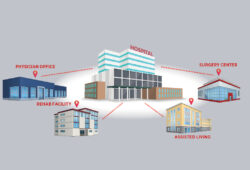Recognizing supply chain’s role in meeting regulatory standards & avoiding penalties

“Whether it’s the face mask you’re wearing, the alcohol swab you’re using or the robot that’s performing the surgery—all of these things come through supply chain,” says Carla Pierson, DNP, MBA, CCRN-K, CPHQ, former Director of Nursing Services at HealthTrust.
Because supply chain is truly integrated into every aspect within a hospital, it has a significant role in ensuring that hospitals meet the Centers for Medicare & Medicaid Services (CMS) regulatory standards on patient safety and quality of care. Hospitals must meet these standards to receive Medicare and Medicaid payments.
There are more than 250 hospital accreditation standards assessing competency in areas such as patient rights, infection control, medication management, staffing and training, emergency preparation, and proper use of supplies—each with a spectrum of criteria. Regulatory risks range from low to “immediate jeopardy,” which can strip a hospital of Medicare and Medicaid funding. For example, having expired alcohol swabs in stock is low risk for patient harm, while administering expired medications or not properly caring for a patient in restraints are considered high risk.
“Supply chain’s role is to vet everything and to make sure products meet all of the standards before they are allowed into a hospital,” explains Pierson. By connecting supply chain and compliance, hospitals will be better positioned to meet regulations while maximizing the quality of patient care and safety.
Competency & context
Supply chain professionals not only ensure that hospital workers have the necessary and appropriate equipment they need, when they need it, but they also should ensure those supplies continue to meet CMS standards. Annual performance maintenance requirements, recalls and other quality issues must be tracked and maintained.
Any changes to a product must be communicated to all relevant teams. “We have to get updated manuals, also known as instructions for use, back out to the staff and the facilities, and ensure they know what they’re supposed to do related to the change,” adds Pierson. “Do you need to send the product back completely? If you’re going to replace it, is there a comparable product on contract?”
Plus, supply chain teams make sure clinicians and staff know how and when to use supplies. “When we allow something in the hospital, supply chain plays a role in ensuring that it is implemented in a way that meets regulatory and accreditation standards,” says Pierson. “The first thing any surveyor looks at when they go into a hospital are the instructions for use to make sure that clinicians, and anybody who’s using it, are competent in performing or using that piece of equipment.”

When bringing in a new product, the supply chain team should include conditions around training and building competency in using that product into the contract. “All of that needs to be agreed upon on the front end and included in the price,” explains Pierson. “We have to make sure that those dots are connected and those loops are closed, so that when it gets to the hospital, the care team is set up for success.”
Jared Dougherty, MBA, MSN, RN, CNML, CCRN-K, Director of Adult Inpatient Nursing Practice at HCA Healthcare, agrees that providing guidelines about the use of a particular product is an important supply chain role. “It’s not just about having the product available. It’s about setting the context behind it, and that’s very much supply chain,” says Dougherty.
The use of restraints, for example, comes with clear regulatory and accreditation oversight that needs to be considered when evaluating products to be added to the hospital’s formulary. Dougherty shares the example of a roll belt: When it’s used with a patient who understands its purpose and who can get out of it, it’s not considered a restraint, but the same device used with a dementia patient might be viewed as one. “You really have to balance how you structure that formulary from a supply chain standpoint because you want to provide options where appropriate, but you also don’t want to open the floodgates too much,” he adds.
The right conversations
Supply chain operations can’t function successfully in a silo. But because its role isn’t always clearly understood within a hospital, supply chain leaders are not always included in necessary teams, such as a hospital’s regulatory readiness team. “Teams that are getting ready for The Joint Commission may not include someone from supply chain if they don’t connect those dots,” explains Pierson.

Expired supplies are a common regulatory finding. But, explains Pierson, nursing and supply chain leaders should work together to identify and replace expired supplies, which requires including supply chain in the appropriate meetings.
At HCA Healthcare, nursing, supply chain and infection prevention teams work together to make sure supply choices are informed by evidence and meet regulatory standards. “We have a monthly collaborative meeting among our three teams. It’s a think-tank session, and we talk a lot about the open contracts and the open formularies,” says Dougherty. For example, a recent discussion focused on arterial lines and ensuring that the process for placing them was standardized across the operating room and inpatient unit.
Sources of truth
With supply chain so interwoven across hospitals and health systems at various levels, a clear, consistent source of information becomes crucial. “With so many individuals involved in a process, you can quickly and easily twist messages on something,” notes Dougherty. “We have started to very clearly call out where those sources of truth lie, so there’s no confusion on the stance of the organization.”
HCA Healthcare has leveraged its patient safety organization to be the source of truth for supply chain alerts. It has criteria for determining when information can be released via the patient safety organization: The alert must have the potential to cause imminent patient harm, and it must have far-reaching impact across HCA Healthcare. Any messaging must also include a clear summary of the issue and recommendations for mitigation.
Dougherty has found that empowering key people and teams to act as champions of information is helpful. “We have a nursing advisory board within the supply chain swim lane,” he says. “We leverage those key groups to act as the champions of information because they’re often tapped to give input along the way. It’s good to have those individual champions of the process scattered across the organization who can say, ‘We knew about this, and this is the process we’re working through.’ ”
The impressive technological advancements seen in the healthcare industry are increasing the varieties of supplies and suppliers available to hospital systems. This is compounding the critical role supply chain plays in meeting regulatory and accreditation standards.
“Hospitals are increasingly being regulated in terms of technology to make sure that the more we automate, we are still maintaining quality, and that starts with supply chain,” says Pierson. “Whether it’s 14 different kinds of needles versus the one we had 15 years ago or the latest robot, as technology advances, supply chain is integrating even further into the standards and regulations.”
For more tips on meeting regulatory standards around supply chain processes, email Jennel Lengel, AVP, Clinical Operations, at jennel.lengle@healthtrustpg.com
Share Email CMS, Q3 2022, Regulations, Standardization





